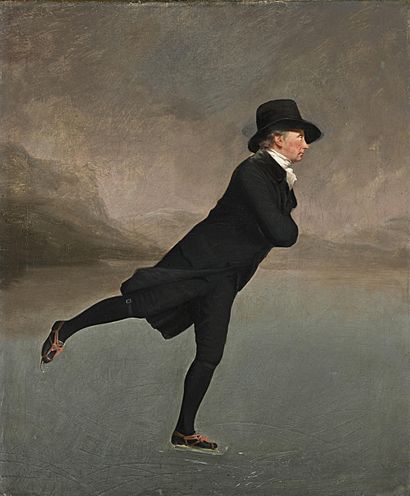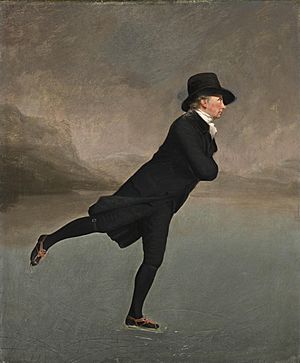The Skating Minister facts for kids
Quick facts for kids The Reverend Robert WalkerSkating on Duddingston Loch |
|
|---|---|
 |
|
| Artist | Henry Raeburn |
| Year | 1790s |
| Medium | oil on canvas |
| Dimensions | 76 cm × 64 cm (30 in × 25 in) |
| Location | National Gallery of Scotland |
The Reverend Robert Walker Skating on Duddingston Loch, often called The Skating Minister, is a famous oil painting. It was painted by Henry Raeburn and is now in the Scottish National Gallery in Edinburgh. For many years, this painting was not well known because it stayed with the subject's family. But since 1949, it has become one of Scotland's most famous artworks. It is seen as an important symbol of Scottish culture. It was created during a time called the Scottish Enlightenment.
Contents
Painting's Journey
Henry Raeburn painted this picture of his friend, Robert Walker, around 1795. At that time, Raeburn was already a popular artist in Edinburgh. He painted many portraits for important people.
When Robert Walker passed away in 1808, the painting was inherited by his wife, Jean. After she died in 1831, it was passed down to their daughter, Magdalen. Then it went to Magdalen's daughter, and finally to Walker's great-granddaughter, Beatrix Scott.
Finding a Buyer
In 1914, Beatrix tried to sell the painting at an auction. She hoped it would sell for about £1,050, but no one bought it. In 1926, Beatrix sold it privately for £700 to Lucy Hume. In 1949, Lucy Hume sent it to Christie's, a famous auction house in London, to be sold.
Before this time, art experts didn't really know about the painting. It wasn't even mentioned in early books about Raeburn's work.
Becoming Famous
Christie's took a photo of The Skating Minister for their sale catalog. This was probably the first time the painting had ever been shown to a wider public. Ellis Waterhouse, who was the director of the National Gallery of Scotland, saw it. The gallery bought the painting for £525.
The painting didn't become famous right away. It wasn't even in a book published by the gallery in 1972 that showed their most important artworks. However, in 1973, it was featured on a set of commemorative stamps. These stamps celebrated 150 years since Raeburn's death.
Later, in 1997, the painting was part of a big exhibition of Raeburn's work in London. It was even chosen for posters advertising the event. In 1998, The Skating Minister traveled to an exhibition in Madrid, Spain. There, images of it appeared on many souvenirs, making it even more widely known.
Who Was Robert Walker?
The person in the painting is the Reverend Robert Walker. He was a minister in the Church of Scotland. He was born on April 30, 1755, in Monkton, Ayrshire. When Robert was a child, his father was a minister in Rotterdam, Netherlands. It's very likely that young Robert learned to skate on the frozen canals there.
He became a minister in 1770 when he was just fifteen years old. He married Jean Fraser in 1778 and they had five children. He also joined the Royal Company of Archers in 1779 and became their chaplain in 1798.
Skating Club Member
Robert Walker was the minister of the Kirk of the Canongate. He was also a member of the Edinburgh Skating Club. This club was the very first figure skating club in the world! The club would meet on Duddingston Loch, which is shown in the painting. They also met on Lochend Loch, about 1.4 miles (2.2 km) north. They would skate when these lochs were frozen solid enough.
What Makes the Painting Special?
This painting is quite unique for Raeburn. It's different from his other portraits because of its style and setting. The way the subject is shown, perhaps hinting at Walker's connection to Holland, reminds some people of Dutch paintings from the 1600s. Artists like Hendrick Avercamp painted similar scenes.
The Reverend is shown skating in a special way called the "travelling position." In this pose, both arms are folded across his chest. His dark, formal clothes stand out against the wild background of Duddingston Loch.
Artist's Touch
Art experts have noted how Raeburn painted this scene. According to Andrew Graham-Dixon, the rocky hills and sky in the background are painted very freely. But the figure of Robert Walker himself is painted very precisely. He looks almost like a dark outline against the icy, misty wilderness. This might suggest that even though the minister seemed proper and controlled, he also had a love for nature.
Art historian Duncan Thomson points out the amazing details in the painting. For example, the tiny buckle on Walker's skate strap and the ribbons tying the skates to his shoes show Raeburn's skill. He was trained as a jeweler and goldsmith. Thomson also highlights the marks left on the ice by the skates. These curving grooves are painted with great detail, showing the froth of ice thrown up by the blades.
See also
- The Skater, 1782 painting by Gilbert Stuart


